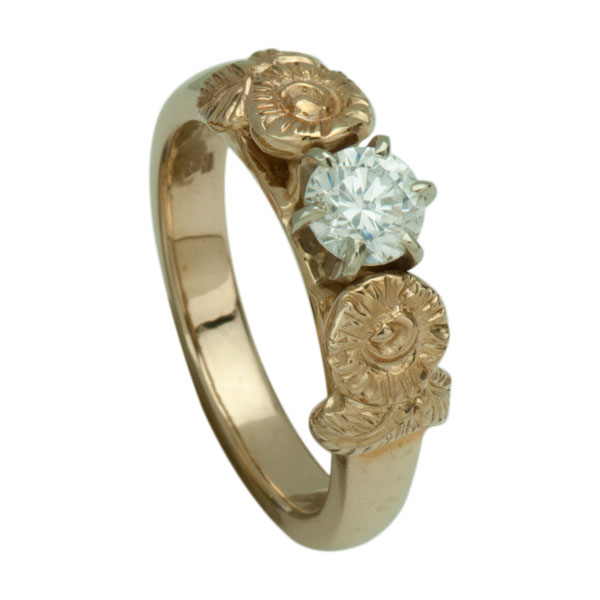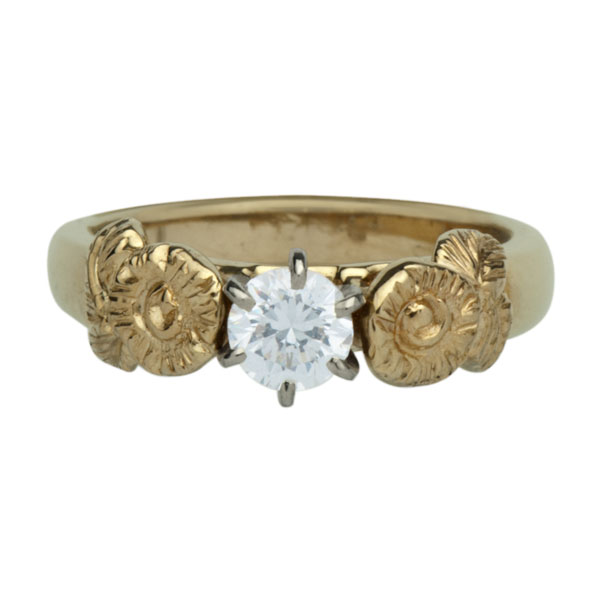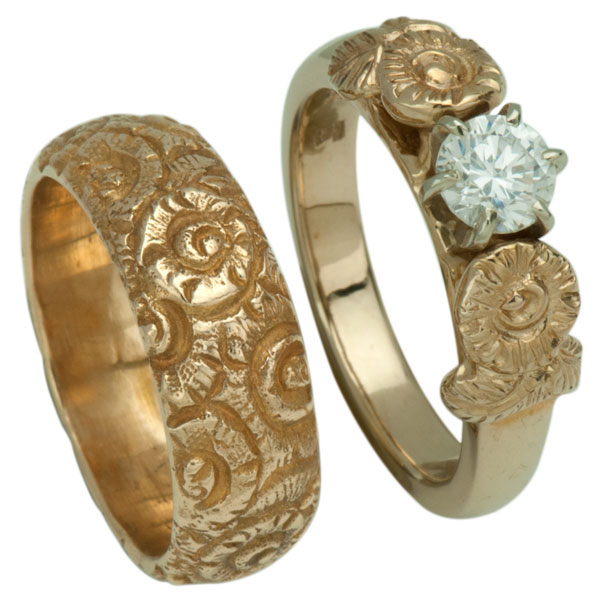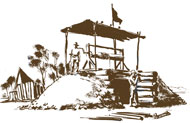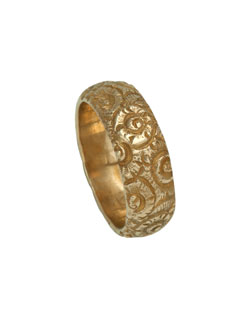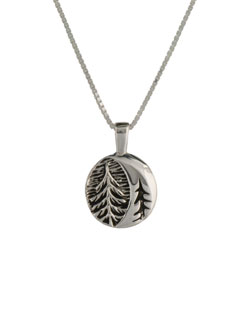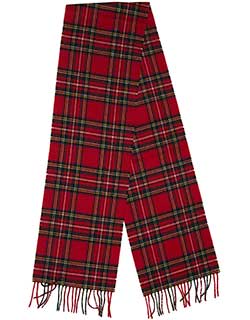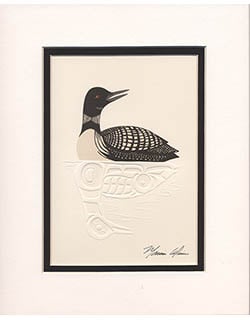Kalgoorlie Engagement Ring
Please note: We are currently transitioning to a new manufacturing jeweler here in the Pacific Northwest. Some of our jewelry is out of stock while we transition. Please let us know if you'd like to be notified when this item is available. 12/01/23
This diamond engagement or anniversary ring matches our Kalgoorlie Ring, with a flower and leaf on each side of the diamond. The diamond is a brilliant cut ½ carat diamond, excellent quality. The diamond is held in a white gold Tiffany crown, the ring is 14 kt. yellow gold or white gold. We chose white gold, rather than yellow, for the Tiffany crown because it provides a better reflective mount to show the brilliance of the diamond and the more durable crown for the diamond. The ring is substantial, to go with the Kalgoorlie ring. Made in USA, exclusive to David Morgan.
This diamond engagement or anniversary ring matches our Kalgoorlie Ring, with a flower and leaf on each side of the diamond. The diamond is a brilliant cut ½ carat diamond, excellent quality. The diamond is held in a white gold Tiffany crown, the ring is 14 kt. yellow gold or white gold. We chose white gold, rather than yellow, for the Tiffany crown because it provides a better reflective mount to show the brilliance of the diamond and the more durable crown for the diamond. The ring is substantial, to go with the Kalgoorlie ring. Made in USA, exclusive to David Morgan.
Please note: We are currently transitioning to a new manufacturing jeweler here in the Pacific Northwest. Some of our jewelry is out of stock while we transition. Please let us know if you'd like to be notified when this item is available. 12/01/23
-
The Story
The original Kalgoorlie ring is one of our family heirlooms, something special from our Australian heritage. Our reproduction of this ring and the matching engagement ring, exclusive to David Morgan, are lost wax castings, made to the highest standards.
Australia was rapidly opening up with large numbers of immigrants coming from Britain towards the end of the 19th century. The government was English -- life was fine for the rich and powerful, but harsh and stultifying for the rest. But Australia had goldfields, and the lure of gold brought hope. Gold also built sophisticated cities early on in Australia, with a full range of urban craftsman drawn from Victorian Britian. Among these, notably in this case, were jewelers.
Our story has two characters, a young man, the suitor, and a young woman. She and her sister had immigrated to Sydney from Northern Ireland in 1879 on subsidized fares during one of Ireland's potato famines. The young man had been lucky in the goldfields near Kalgoorlie, in the far west of Australia. He had a ring cast from gold nuggets he dug and gave this ring to the young woman living far to the east in Sydney. Although the details of this romance have been lost, the ring itself has been passed down through the generations.
-
Ring Sizing
Rings need to fit well to be comfortable and to minimize the risk of loss from your finger. A jeweler has sized rings to help you determine your size. If you wish to measure your size in the comfort of your own home we can supply a set of plastic sized rings.
Finger size changes with temperature - less blood flows to the hands when the hands are cold, so the fingers are then slimmer. Measure your fingers when your hands are at their usual temperature. The correct size allows the ring to just slip over the knuckle, not loosely but not so tightly that heroic efforts are required to remove it. Remember that people's left and right hands are usually not identical in size. It should be kept in mind that a wide ring will fit a little more tightly than a narrow ring of the same size.
-
Our Diamonds
Diamonds
The diamonds used in our engagement and anniversary rings have a color specification of H/I (near colorless) and a clarity specification of SI 1/2 (having inclusions which can be seen under a magnification of 10X, but are clean to the naked eye). The most significant factor in the quality of a diamond is the cut, entailing both precision of the individual facets and importantly the proportions of the cut. Diamonds must be selected with particular attention to the cut to ensure maximum brilliance. The proportions, the ratio of the diameter to the depth of the diamond, determine how efficiently the diamond reflects light, and hence its brilliance. Our diamonds are selected for us by our local manufacturing jeweler, in whose experience, skill, and integrity we have developed full confidence over many years of association. We are confident you will be pleased.
The weight of diamonds is measured in carats, one carat equalling 0.2 grams. Carats are divided into 100 points. Jewelry with multiple diamonds is often described giving the total diamond weight. For instance, our Tlws Olwen pendant has three 5 point diamonds for a total diamond weight of 15 points or 0.15 carats.
Diamonds are cut from natural shape rough stones. The art of the diamond cutter is to extract the maximum value from each stone. This is not always the same as cutting the best possible finished diamond from the stone, or only well-proportioned finished diamonds from the stone. While there is little variation in facetting there are significant variations in proportions. If a rough stone will yield a round diamond of diameter greater than the diameter which would be in proportion to the depth that can be cut from the stone, the cutter may elect to take the larger diameter (and so greater carat weight), at the expense of brilliance. Similarly a stone might be such as to yield one large diamond with a major flaw, or one or more less flawed diamonds. The cutter will make a choice depending upon the comparative value. The skill and judgment of an experienced jeweler is required to select those diamonds having full brilliance, with the best balance between color, clarity, and cut.
Care of Diamonds
Diamonds can be damaged by impact. Some protection against impact damage is afforded by the prongs of the mount which shield the diamond. There is less protection, and a greater potential for damage, with larger diamonds. We suggest not wearing your diamond ring when engaged in activities where the ring might be hit on hard objects, such as sports or housework.
Loss of diamonds can occur if the prongs of the mount are bent out of place or worn. The prongs fit tightly against the diamond, but still can be caught inadvertently on an edge and bent. Inspect your ring periodically, and if a prong is bent or the diamond loose have the diamond re-set. The protruding ends of the prongs wear over the years and hold the diamond less securely. Again, inspect the prongs periodically for wear and if at all in doubt take your ring to your jeweler for examination.
Diamonds have an affinity for skin oils, soap, cosmetics and grease. Cleaning your diamond regularly will ensure its full brilliance is visible. The simplest cleaning method is to wash in warm water with any mild liquid detergent. Brush the diamond gently with a toothbrush while in the sudsy water. Rinse under warm running water then pat dry with a soft lint-free cloth. Take care not to lose your ring down the drain!
